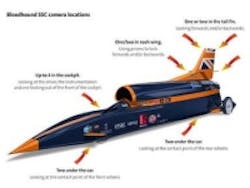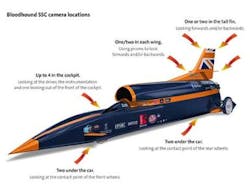Vehicle attempting to break world land speed record has vision system put to the test
Led by a team of top engineers, The Bloodhound Project has an ultimate goal of attaining a 1,000 mph world land speed record with its Bloodhound SSC supersonic car. The car, which is currently in development, recently had its first phase of rocket plume imaging tests conducted in order to determine to optimum wavelength range for imaging.
The tests were carried out by Dr. Adam Baker at Kingston University in conjunction with STEMMER IMAGING, which was in charge of developing the vehicle’s vision system. For the visible wavelength range, a Teledyne DALSA Genie M640 camera was used. M640 GigE cameras feature a 1/3” Sony CCD image sensor with a 7.4 µm x 7.4 µm pixel size and 640 x 480 pixel array, and operate at 64 fps at full resolution.
For the UV wavelength range, a JAI CM140GE UV camera was used. The CM140GE camera features a UV-sensitive 1/2" monochrome Sony ICX407BLA CCD image sensor with 4.65 µm x4.65 µm pixel size and 1380 x 1040 pixel array, and operates at 16 fps in full resolution. In addition, the camera features extended sensitivity to below 200 nm.
An Allied Vision Technologies Goldeye P032 infrared camera was used to image the infrared wavelengths. The Goldeye P032 features an InGaAs infrared sensor with 25 µm x 25 µm pixel size and 636 x 508 pixel array, and operates at 30 fps at full resolution. The P032 has a SWIR spectral range of 900 – 1700 nm.
All cameras were linked to an ADLINK EOS embedded vision system equipped with an Intel Core i7 processor. The EOS 1200 features four independent GigE ports for multiple GigE Vision device connections with transfer rates up to 4.0 Gb/s.
In order to accommodate the high volume of data generated by the system, a custom version of Vision Expert’s Gecko recording software was used to perform real-time video compression. Gecko connects to GigE Vision cameras and records video to standard formats, including AVI and MPG. It enables the viewing, controlling, and recording of up to four cameras and uses GenICam standard controls to change camera parameters.
Monitoring the output of the rocket plume is expected to play an important role in the optimization of the rocket and jet engine-powered Bloodhound vehicle as it its developed to break the aforementioned record, according to STEMMER.
View more information on the Bloodhound Project.
See other articles from our June 9 e-newsletter.
Also check out:
How imaging factors into quest to break world land speed record
Vehicle attempting world land speed record receives first vision system
Rocket test captured at high speed
Share your vision-related news by contacting James Carroll, Senior Web Editor, Vision Systems Design
To receive news like this in your inbox, click here.
Join our LinkedIn group | Like us on Facebook | Follow us on Twitter | Check us out on Google +
About the Author

James Carroll
Former VSD Editor James Carroll joined the team 2013. Carroll covered machine vision and imaging from numerous angles, including application stories, industry news, market updates, and new products. In addition to writing and editing articles, Carroll managed the Innovators Awards program and webcasts.

